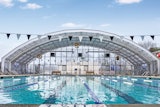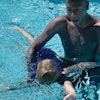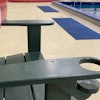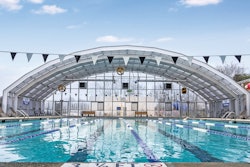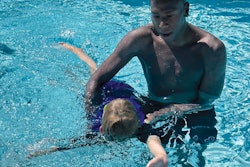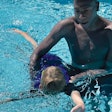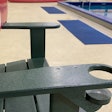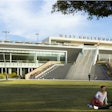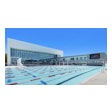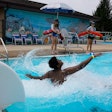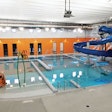Today's aquatic safety personnel are better equipped and prepared than ever, thanks to enhanced technology and training.
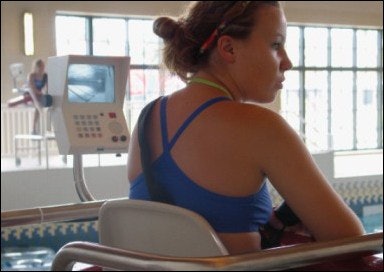
In the world of aquatics safety, Mike Fischer has been there and done that. A former lifeguard, canoe instructor, water safety instructor and lifeguard instructor, he has attended four national aquatic safety schools. And now, 26 years after he donned his first pair of lifeguard swim trunks, Fischer is the aquatics director for the city of Cape Coral, Fla., home to two busy aquatic facilities - a community pool and a 12-acre waterpark.
Combined, Cape Coral's aquatic facilities employ as many as lifeguards each year. The Sun Splash Family Waterpark, by itself, requires about 120 lifeguards, meaning that at the start of each season, Fischer is faced with the same challenge: the training of each of those guards to be ready to save lives in the event of an aquatic emergency. It's a task that Fischer does not take lightly.
"We're extremely dedicated to quality," says Fischer, adding that his lifeguard staff has regularly earned national recognition for its service. "Our ultimate goal is to reduce or eliminate drowning. That should be the first priority of anyone who goes into aquatic safety."
Few would disagree. However, there are differences in opinion among industry experts, namely those employed by organizations that specialize in aquatics safety and lifeguard training, on how best to prepare lifeguards and other facility staff to handle emergencies. With respect to teaching guards the technical skills required for the job, Fischer says there's no distinguishing one training organization from another. "I've been with the American Red Cross, Ellis & Associates and Starfish Aquatics. The skills, in and of themselves, are completely similar," he says. "No matter what you call it, a cross-chest carry is a cross-chest carry. A rescue tube is a rescue tube. The technical skills are the same wherever you go."
What does separate the major training organizations are factors such as cost, content delivery and quality control. Ultimately, it's up to each aquatic director to determine which training system works best for his or her staff. "I have nothing but good things to say about every agency," says Fischer. "But we have to look at what is best for us."
The increasing variety of aquatic safety programs is a good thing for the industry, says Bert Forde, president of Midwest Pool Management, which manages more than 30 commercial and municipal aquatic facilities in St. Louis and Kansas City, Mo. She believes that as competition among safety and training organizations becomes more intense, end users will reap the benefits through enhanced technology and training programs. "I love that the training is constantly improving, and that the wheels are in motion," she says.
Lisa Austin, director of risk management for the YMCA of Pikes Peak Region in Colorado Springs, Colo., agrees. "The diversity of training programs - I don't necessarily want to say this because I want to support the Y's programs - but anytime there is a difference in training, it makes you go out and make sure that what you're doing is the best," she says. "We're constantly reevaluating what we do."
Aquatic facility operators' willingness to critically reexamine current facility operations and consider new or unfamiliar training techniques with an open mind is helping set up lifeguards and other potential first responders for unprecedented success. Not only is there greater opportunity than ever before in the aquatic safety profession, but learning the trade has been made much easier for those individuals entering the ranks - the overwhelming majority of whom are high school or college students.
That said, the cost of undergoing lifeguard training can serve as a deterrent for many young people. "It's a significant factor for our target employee market, which is made up of 16- to 21-year-olds," says Fischer, who formerly had to charge lifeguard trainees $165 for the certification course. "This year, we were able to cut costs to $65 per lifeguard - that includes certification, training materials, uniform, lanyard, everything. We've made it extremely accessible for every element of our community for whom $165 might have been tough to handle."
It goes without saying that keeping training costs to a minimum can also positively impact an aquatic facility's bottom line. "We want to break even, not necessarily make a profit," says Forde, whose company is responsible for the hiring and training of 800 lifeguards each summer season.
For some facility managers, it is just as crucial to consider the cost of turning experienced guards into lifeguard instructors. "We try to keep at least three lifeguard instructors on staff," says Fischer. "With our old agency, it cost $400 per instructor. Historically, only three people could pursue instructor certification because of the cost. Now, we can get one of our instructors certified at the national headquarters, and that person can come home and teach an unlimited number of lifeguard instructors. The only cost is for additional instructor textbooks, which at $40 each is minimal. Instead of three individuals training 120 lifeguards, we have 10 instructors training 120."
Also helping to expand educational opportunities for aquatic safety personnel is the partnering of major training organizations with independent safety agencies such as the Emergency Care and Safety Institute (ECSI) and the American Safety & Health Institute (ASHI). These institutes have opened to their training partners vast libraries of emergency care procedures, allowing lifeguards to keep pace with the industry's elevated standards of care. In addition to learning standard lifeguarding protocol such as basic first aid and CPR, aquatic safety personnel are now able to take courses on how to handle bloodborne pathogens and treat drowning victims with emergency oxygen administration and automated external defibrillators (AEDs).
An added benefit to facilities that partner with the Savannah, Ga.-based Starfish Aquatics Institute, which relies on ASHI to deliver its aquatic safety curricula, is the opportunity to train employees in non-aquatic programs. ASHI also offers Occupational Safety & Health Administration- and Department of Transportation-approved courses as diverse as child-care safety, driver safety and even forklift operations. "We haven't been able to scratch the surface of all the programs available through ASHI," says Fischer. "We just constructed a youth/teen center right next door to our waterpark. This falls in line with our desire to provide job opportunities to those kids. For those individuals not yet 16 and who can't lifeguard, we can at least offer them child-care training and increase their marketability and job skills. We have a lot of young families in our area, and we have a need for babysitters."
As a timesaver to both aquatic facility operators and lifeguards-to-be, many of these courses are being delivered online. For example, individuals who opt to take Ellis & Associates' National Pool & Waterpark Lifeguard Training Program (NPWLTP) online are assigned a secure username and password, and are directed through four comprehensive modules that represent the knowledge components of Ellis & Associates' traditional lifeguarding class. Students can log on anytime and are allowed to complete the online class at their own pace. The required time to complete the four online modules, which feature streaming video and interactive simulations, is seven hours - or roughly half the time students traditionally spend in a classroom setting.
"Online training is a didactic version of our textbook," says Rac Carroll, an Ellis & Associates vice president. "We're in our third year now, and we've seen a significant increase in the use of the program. Its advantages provide for less in-class instruction time, less lecture time, while still focusing on the practical and test-preparation skills." After completing the modules, participants take a secured 50-question final written exam. At that point, participants are required to locate an authorized NPWLTP instructor to demonstrate the physical skills of lifeguarding.
Though she supports online lifeguard training, Forde is quick to stress the indispensable nature of mock rescues and other physical skills training sessions. "I think online training is a good tool, especially for those people who just need recertification," she says. "But you've got to get them in the water."
Aquatic safety experts hold similar attitudes toward high-tech drowning-detection systems, two of which currently exist on the market. These systems - both rely on digital camera technology to monitor in real time pool activity and alert aquatic personnel in the event of a drowning or unauthorized pool entry - are viewed by many aquatic managers as aids.
Earlier this year, the YMCA of Pikes Peak Region equipped its seven aquatic facilities with Poseidon Technologies' drowning-detection system. Austin was pleased to see how well her lifeguards incorporated use of the system into their daily routines. "The lifeguards have not gotten lazy. Now it's a competition between them and the machines. You don't want the system to beat you," she says. "As a risk manager, I like having a backup system. I don't want to rely entirely on Poseidon and get away from lifeguarding, but I think having a combination of the two in place makes us safer."
Poseidon systems have received several upgrades since debuting in the North American market in 2001. Large, wall-mounted LED screens have replaced belt-worn pagers as the means by which lifeguards are alerted to drownings. "They kept getting kicked off chairs and they weren't water-resistant," says Joshua Brener, an Atlanta-based consultant and former marketing manager for Poseidon Technologies/Vision I.Q. The screens flash a visual alert, directing lifeguards to specific pool coordinates (for example, a person drowning in one quadrant of a 25-yard-by-50meter pool might be located at 10 yards, 40 meters, or 10 x 40). "The beauty of this system is that the lifeguard doesn't watch a screen," says Brener. "He watches the pool, as he's supposed to do."
Recent advances in digital camera technology have also helped make drowning-detection systems more efficient. "In digital cameras, it's all about megapixels," says Brener, referring to cameras' ability to zoom in on and enhance distant images. "Whereas before, we needed 16 cameras for a 25-meter pool, now we need only four."
Be aware, however, that the system's proficiency at detecting potential drownings depends largely on water clarity. For that reason, Brener says, the Poseidon system has a feature that automatically notifies aquatic staff of unsatisfactory water quality.
In the pipeline at Poseidon is a product called NightGuard designed to provide after-hours pool monitoring. Brener suggests such an installation might also be ideal for multiple-pool facilities. "You could switch NightGuard on at your two unused pools and manually monitor the active pool," he says. "If the alarm sounds, you can send a lifeguard over to the other pools to check things out."
Remote monitoring is a feature of SwimGuard's swimmer safety system that Jordan Wienke has yet to fully explore. As the aquatic supervisor at The Lodge at Des Peres, Mo., Wienke has the ability - if she chooses - to view at any time all the goings-on of her aquatic center from home via a secure web site. "I haven't used it yet because I figure that by the time I get there, it'll be too late," she says. "We have other security protocol in place that could respond much quicker than I."
One feature of the SwimGuard system that Wienke has used is its data recording and video playback capabilities. "It's like a recording studio. According to the company, it holds information for two weeks, but mine holds data for about a month and a half," she says. "The system will show which camera view recorded an event and I can burn that incident onto a DVD. Or, I can bring in my lifeguards and show them what happened. What's interesting is that the lifeguards actually critique themselves. They say things like, 'Omigosh, I should have done this or that.' It's made them more conscious of what they do. That has been an unexpected benefit."
Wienke has also used the system's playback capability to teach lifeguard trainees. "I can tape their training sessions in the water, and then bring them in and show them, 'This is where you need to put your hand,' " she says.
Lifeguard training is one of the uses for which the system was designed, says Swimguard's UK-based marketing manager Kirsty Gale. "We're not trying to dictate how facilities run their operations or interrupt a lifeguard's daily routine," she says. "We're trying to enhance operations, enhance the lifeguard's view."
Most notably, says Wienke, that view is enhanced by a chair-mounted monitor/intercom console that lifeguards are audibly reminded to check at specific intervals (via a timed alarm that can only be preset by an aquatic manager). Each of the monitors in The Lodge at Des Peres is tied to one of 11 underwater cameras. From her pool manager's office, Wienke can simultaneously monitor on a single screen all 11 camera views. She can also tell if her lifeguards, each of whom must log on to a monitor console with an individually assigned four-digit code, are checking their screens at the prescribed intervals. "I set the timer to beep, say, every 15 or 20 seconds to remind them to scan or check the monitor," she says. "The system times how long it takes them to do that scan, so I can say to a lifeguard, 'It took you 30 seconds to respond to the beep.' "
The intercom system has also proven to be a useful feature. "If someone needs help checking the water quality or assistance during a rescue, he or she can call the other lifeguards or the lifeguard office from his or her chair," says Wienke.
There are, however, several drawbacks to The Lodge at Des Peres' pool monitoring system, one of which is more a nuisance than anything. "Most of the blocked views we get are from kids leaning against the camera and pulling their pants down or flipping the camera off," says Wienke. "But I can look at the screen, come out of the office, and say, 'Hey you! Get off the wall!' "
What can't be solved (at least not yet) is the inability of SwimGuard's cameras to zoom. Also, in contrast to what has been experienced at the YMCA of Pikes Peak Region, Wienke notes that her longtime lifeguards have had a harder time incorporating the monitor check into their routine. "It's tougher to transition old guards, who have been doing things a certain way for so long, to use the monitors," she says. "The new lifeguards get used to the monitor real quick. For them, it's no problem."
Currently both the Poseidon and SwimGuard systems require hard-wired setup, but wireless capabilities might be available soon - which could potentially save facility operators a great deal of hassle, not to mention thousands of dollars in retrofit costs.
Neither company is willing to publicly disclose the cost of installing a drowning-detection system, since, in Gale's words, "every pool is obviously very different and has very specific needs." Regarding the cost of the system at The Lodge at Des Peres, which was installed several months after the facility opened in fall 2003, Wienke says, "I can tell you that our director negotiated one heck of a deal."
In addition to advances in technology, those entrusted with training aquatic personnel are constantly tinkering with basic tools of the trade to propel lifeguarding, as a career, to its most professional standing yet.
This fall, the American Red Cross began an extensive retooling of its entire lifeguard training program, and also plans to update its Emergency Cardiovascular Care Guidelines, the latest version of which was published in 2000. "We're working with the International Lifesaving Federation and are hoping to get a new version of the guidelines out by the end of 2005," says Mike Espino, the Red Cross' manager of aquatics technical development. "We'll be assessing any and all suggestions. We're also looking at certain trends, particularly within parks and recreation departments. For example, we're looking at spraygrounds and how they affect lifeguarding, if they do at all."
In recent years, the industry has been witness to modification of standard equipment such as lifeguard stands and chairs that enable guards to more quickly respond to an aquatic emergency.
Water scanning techniques have also improved. Over the past several years, Ellis & Associates, in partnership with Poseidon, has conducted tests to assess the effectiveness of the former's "vigilance awareness training," or the training of lifeguards to recognize a drowning victim. The tests involved slipping a mannequin into a pool and letting it sink to the bottom, all without the lifeguard's knowledge. Researchers then waited to see how long it took for the guards to spot the body on the pool floor. "The study showed it took, on average, 1 minute and 14 seconds to identify the mannequin," says Carroll. "We know our lifeguards are good at identifying surface victims. They do 35,000 rescues a year. But that forced us to make changes, to improve our vigilance training. In 2003, we saw average recognition time come down to 24.7 seconds. That's 67 percent better."
Carroll also notes industry innovations such as the "FiveMinute Scanning Strategy," which was developed by Penn State University aquatics director Tom Griffiths and has been adopted by Ellis & Associates as standard protocol for all of its licensed guards. "Lifeguards must change their posture, position or perspective every five minutes," Carroll says. "It keeps them in an attentive and alert stage. In a meeting, how long is it before you catch yourself yawning or fidgeting, to where you're not as vigilant? Obviously, that can be disastrous in a lifeguarding environment."
Recent years have also introduced to the pool deck a heightened emphasis on individual accountability. Ellis & Associates expects its lifeguards to exhibit this quality through "progressive bottom scans." "Before lifeguards rotate in or out of their shift, they should scan the bottom of the pool," says Carroll. "This provides them with the opportunity to take an ownership mentality, to know that their stations are clear before they sit down, and that they're clear when they leave their chairs. We're basically telling them, 'We don't want you to accept somebody else's work as your own. The worst thing you'd want is to get up on your chair and realize that there is somebody at the bottom of the pool.' "
Starfish Aquatics, which like Ellis & Associates conducts regular unannounced audits of its partner facilities, considers individual accountability and teamwork to be equally important. Lifeguards and facility managers must all pass muster in each of five categories: prevention, surveillance, management of a conscious victim, management of an unconscious victim, and professionalism and personal safety. "A lot of times, the lifeguard may be trying to do his or her job right, but the facility may not be set up to allow the lifeguard to do a good job," says Starfish Aquatics president and founder Jill White.
Carroll says that it is especially critical - and beneficial - for facilities that enter into risk-management contracts with organizations like his and Starfish Aquatics to proactively seek out opportunities for self-evaluation. "This process is a partnership," he says. "It takes both parties to maintain and raise the bar."
"The quality of lifeguarding falls back on the facility management," adds Tom Werts, an aquatics specialist with the American Red Cross of Central Florida and president of Aquatic Safety Consulting Inc. "It is only as good as the people on that pool deck doing the training."
Espino believes that in-service training is the best way to ensure quality lifeguarding, year in and year out. "Everybody wants training programs that are fast, quick and cheap. All agencies can provide that," he says. "But there is also a responsibility to provide guards with continued training."
As aquatic manager, Fred Gusel oversees regular in-service training for all aquatics personnel in Bolingbrook (Ill.) Park District. Four hours a month is reportedly the industry standard, but Bolingbrook Park District officials mandate for their aquatics staff six hours of in-service training. Gusel says that in-service drills vary from month to month, but generally they focus on addressing mistakes that either he or other supervisors noticed in previous weeks.
In Bolingbrook, continuing aquatic safety education isn't limited to the staff. Chaperones of all special groups that visit Pelican Harbor Indoor/Outdoor Aquatic Park, including daycamps and other youth groups, must undergo a brief education session before their kids are let loose in the park. To prepare them for potential aquatic emergencies, "we take 10 minutes to explain to camp counselors and chaperones what to look for and how to position themselves. It has really helped outside groups be more proactive," says Gusel. "If they're going to be here for four hours, we tell them to call the kids back in to do a head-check once every hour. Our bather load capacity is roughly 2,000 people. Our lifeguards already have a big enough task to make sure all 2,000 people are safe and having fun without having to know where people's kids are at all times."
Programs like these delight Forde, who has made it a personal crusade to increase awareness among parents of pool-going children. "Parents don't always understand that they need to be within arm's reach of their children," she says. "Often, they pull out a lounge chair and a book and turn over supervision of their children to the lifeguards. The lifeguards are certainly capable, but they're not babysitters."
For that reason, Forde advocates the inclusion of adult learn-to-swim programs to help parents feel more comfortable in the water and be prepared to assist their children should they need help.
Cape Coral's Fischer also believes that comprehensive aquatic safety involves more than high-tech equipment and advanced lifeguard training. In his mind, everyone who sets foot in an aquatic facility plays a vital role. "Proactive lifeguarding is absolutely the best thing, coupled with an effective learn-to-swim program, to provide the community with skills to swim safely and responsibly," he says. "Here in Cape Coral, we're right by the ocean, people have pools at home - there is water everywhere. But I always tell people, 'You have to respect the water.' "









